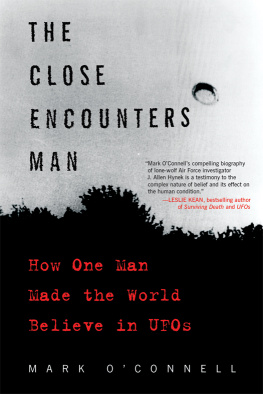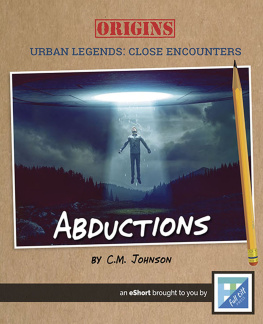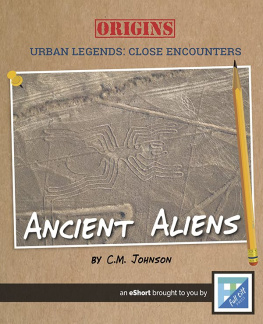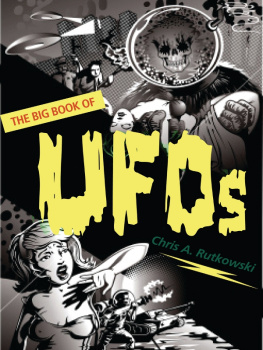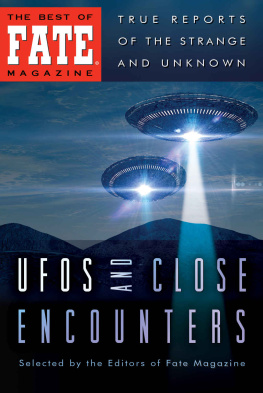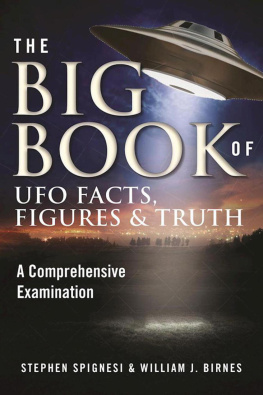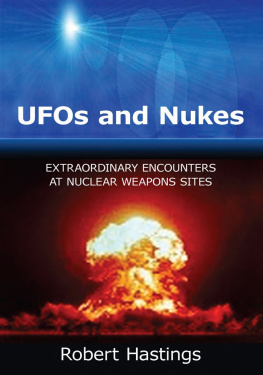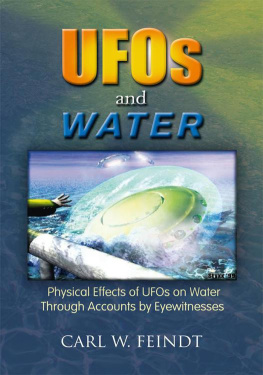Mark O’Connell - The Close Encounters Man: How One Man Made the World Believe in UFOs
Here you can read online Mark O’Connell - The Close Encounters Man: How One Man Made the World Believe in UFOs full text of the book (entire story) in english for free. Download pdf and epub, get meaning, cover and reviews about this ebook. year: 2017, publisher: Dey Street Books, genre: Non-fiction / History. Description of the work, (preface) as well as reviews are available. Best literature library LitArk.com created for fans of good reading and offers a wide selection of genres:
Romance novel
Science fiction
Adventure
Detective
Science
History
Home and family
Prose
Art
Politics
Computer
Non-fiction
Religion
Business
Children
Humor
Choose a favorite category and find really read worthwhile books. Enjoy immersion in the world of imagination, feel the emotions of the characters or learn something new for yourself, make an fascinating discovery.
- Book:The Close Encounters Man: How One Man Made the World Believe in UFOs
- Author:
- Publisher:Dey Street Books
- Genre:
- Year:2017
- Rating:4 / 5
- Favourites:Add to favourites
- Your mark:
- 80
- 1
- 2
- 3
- 4
- 5
The Close Encounters Man: How One Man Made the World Believe in UFOs: summary, description and annotation
We offer to read an annotation, description, summary or preface (depends on what the author of the book "The Close Encounters Man: How One Man Made the World Believe in UFOs" wrote himself). If you haven't found the necessary information about the book — write in the comments, we will try to find it.
Mark O’Connell: author's other books
Who wrote The Close Encounters Man: How One Man Made the World Believe in UFOs? Find out the surname, the name of the author of the book and a list of all author's works by series.
The Close Encounters Man: How One Man Made the World Believe in UFOs — read online for free the complete book (whole text) full work
Below is the text of the book, divided by pages. System saving the place of the last page read, allows you to conveniently read the book "The Close Encounters Man: How One Man Made the World Believe in UFOs" online for free, without having to search again every time where you left off. Put a bookmark, and you can go to the page where you finished reading at any time.
Font size:
Interval:
Bookmark:
To Monica, the star-stuff in my life
This book was born in a basement in Chicago, amid a ring of overfull bookshelves and dented, dilapidated file cabinets. The assemblage of obscure journals, redacted government documents, and plaintive correspondence packing these shelves and drawers was nearly all that was left of the Center for UFO Studies (CUFOS), a UFO research center that had been founded in a Chicago suburb in 1973 by astronomer Dr. J. Allen Hynek.
I had been visiting the archives in search of interesting material for my UFO blog, and on one visit, Dr. Mark Rodeghier, who now stores these antiquated remnants of Hyneks work in his Chicago home, invited me to make use of these ramshackle memory banks to write the definitive account of Dr. Hyneks remarkable dual careers. This was to be the first telling of Hyneks significant accomplishments as an astronomer who pioneered the science of celestial imaging and as a researcher who was on the scene at many of the most amazing UFO encounters in history, and made serious discussions of the UFO phenomenon scientificallyand sociallyacceptable.
From a lifetime of studying the UFO phenomenon, I knew of Hyneks pioneering research through his writings, media appearances, and short but notable movie career during his heyday from the 1960s to the 1980s, but when I started to delve deeper into the CUFOS archives, I realized that I understood very little about the man. Hynek had spent nearly twenty years debunking UFO reports for the U.S. Air Force and was considered a sellout, a dupe, and a coward by many Americans for helping the air force cover up what they believed the government knew about the UFO mystery. For this sin, he was hated in UFO circles. But he was also ultimately disowned by the air force, because over time his views about UFOs changed dramatically and he began to demand that the government and the scientific establishment conduct a scientific study of the phenomenon, to find out what was really going on. What kind of man, I wondered, could calmly stand at the center of a decades-long conflict and be equally despised by both sides? This is what I wanted to find out.
That drama alone made Hynek a fascinating character to want to write about, but then there was his other historyhis brilliant yet largely ignored career as an astrophysicist. This was a man who helped win World War II with science, who discovered how and why stars twinkle (not a small thing), and who helped determine the landing sites for the Apollo moon missions. Along the way, he pioneered crowdsourcing, developed the worlds first global satellite tracking network, discovered a record number of supernovae, and paved the way for the Hubble Space Telescope. If Hyneks career as a UFO researcher was universally misunderstood and misjudged, his career in astronomy seemed to have been swept under the rug in its entirety. When I discovered that the records of Hyneks scientific triumphs and failures were housed at Northwestern University and the University of Chicago (in significantly better shape than the CUFOS files), and within a few miles of my home, it seemed that the true, complete story of his life and work was demanding to be told. And it came to me as mystically as any of Hyneks career pursuits.
In very little time, I realized that Hyneks two careers informed each other in fascinating ways. Had he not been an astronomer, he would never have found himself at the epicenter of the UFO phenomenon, and had he not been at the center of the UFO furor, he might never have risen to prominence as an astronomer (nowhere was the overlap between Hyneks two careers more dramatic than in his very public, decades-long battle for scientific respectability against astronomer and UFO mocker Dr. Carl Sagan). Furthermore, had his life not followed the exact trajectory that it did, he might never have had an unforgettable cameo in Steven Spielbergs Close Encounters of the Third Kind, the research for which was borrowed from Hyneks professional findings. In fact, Hynek and Spielberg corresponded through letters leading up to the production of the film, evidence that not only UFO enthusiasts held Hynek in high regard.
This book, then, is an attempt to rectify Dr. Hyneks story, to find the heroism, humor, and humanity in a man whose name has been relegated to a basement full of file cabinets when it should rightly be written in the stars.
We didnt always put dead aliens on ice or pickle them in jars. We used to give them proper burials.
No one knows where he came fromif it was a heand no one knows the exact cause of his death. Nor does anyone know if his soul rests in peaceif he had a soulbut there is a dead alien reportedly buried in the town cemetery in Aurora, Texas.
This one didnt get spirited away to a secret base in Nevada or hidden in a high-security hangar in Ohio. He wasnt subjected to an autopsy and he didnt appear on cable TV. His existence was neither leaked nor covered up. He got a brief mention in a Dallas newspaper item two days after he died, and then the media, such as it was, seemed to forget he ever existed.
Perhaps the spaceman didnt achieve any lasting fame because he met his end in 1897, a full fifty years before the modern flying saucer phenomenon began.
At six in the morning on April 17 of that year, early risers in Aurora were witness to an object of pure wonder: a massive, heavier-than-air ship sailing over the center of town, seeming to traverse the sky without the aid of the wind. The wonder lasted only a few minutes, for the metallic airship, apparently suffering from some mechanical malady or the sudden incapacitation of its pilot, began to lose speed and altitude as it careened into the heart of town. As astonished Aurorans scrambled for cover, the airship swooped slowly over the town square and smashed into a windmill on a farm belonging to the towns justice of the peace, Judge Proctor.
The airship was far more fragile than it appeared, however, for the impact with the windmill caused a spectacular explosion and the complete destruction of the strange craft. The windmill was obliterated with it, as was Proctors flower garden. Miraculously, his cabin was left untouched. Nonetheless, the airships wreckage was scattered over an area of several acres, according to an eyewitness account in the April 19, 1897, Dallas Morning News. The ship was too badly wrecked to form any conclusion as to its construction or motive power. It was built of an unknown metal, resembling somewhat a mixture of aluminum and silver, and it must have weighed several tons, claimed the reporter S. E. Haydon. The town is full of people to-day who are viewing the wreck and gathering specimens of the strange metal from the debris. Later, the remaining shards of wreckage were dumped in Judge Proctors well.
The remains of the pilot were treated with far more respect. If you passed away in the town of Aurora, apparently you were buried in the town cemetery as a matter of course, no matter who you were or where you came from. In that sense the airship pilot was no different from anyone else, and his simple grave was said to be marked by a simple stonelong since gone missingbearing an etching of his ship. Buried with him were some papers found on his person that bore unknown hieroglyphicsa captains log of his travels, Haydon supposed. How the citizens of Aurora felt about the airship pilot and his personal effects sharing consecrated ground with their kin was never mentioned in his account, but there must have been some misgivings when people got a look at the deceased. The pilot of the ship is supposed to have been the only one on board, Haydon wrote, and while his remains are badly disfigured, enough of the original has been picked up to show that he was not an inhabitant of this world.
Font size:
Interval:
Bookmark:
Similar books «The Close Encounters Man: How One Man Made the World Believe in UFOs»
Look at similar books to The Close Encounters Man: How One Man Made the World Believe in UFOs. We have selected literature similar in name and meaning in the hope of providing readers with more options to find new, interesting, not yet read works.
Discussion, reviews of the book The Close Encounters Man: How One Man Made the World Believe in UFOs and just readers' own opinions. Leave your comments, write what you think about the work, its meaning or the main characters. Specify what exactly you liked and what you didn't like, and why you think so.

